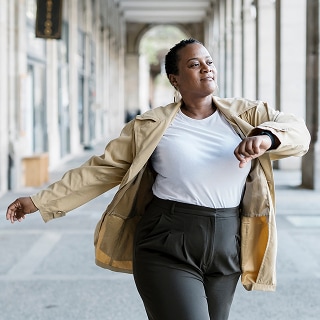
Discover a collection of stories from our authorities on the Longevity Lifestyle, created by ROAR Forward, a collaborative of longevity thought leaders and content creators.
Walking is as familiar to us as breathing. It's one of the easiest, most natural forms of movement we know. Yet behind that simplicity lies incredible power. A low-impact, highly accessible activity that benefits nearly every system in the body, walking strengthens the heart, improves circulation, boosts metabolism, supports bone density, aids in digestion and enhances joint mobility. Mentally, it can lift your mood, lower stress, sharpen focus and even stimulate creativity. “It's one of the easiest ways to keep your body and mind moving toward better health every single day,” says Lori Diamos, MS, PT, FAFS. “Research shows health benefits begin with as few as 7,000–8,000 steps per day and that it’s best to aim for at least 150 minutes of moderate intensity walking per week.”
Ahead, fitness experts share creative strategies to better align your walk with your long-term health and fitness goals.
1. Vary Your Speed
"Mixing up your pace will boost your cardiovascular conditioning faster than just sticking to one rhythm,” says Diamos. “Alternate your speed between brisk, moderate, and recovery paces.” A fun way to vary your speed is by using markers to determine when you’ll slow down or speed up. “If you’re walking on the street, you can choose to increase your pace when you see a red car and keep that pace until you see a blue car,” suggests JaLorean Hayes MPH, RN, and founder of Meal Maps. “The point is to have specific cues that help you change your pace.”

2. Work in Different Movements
Channel your inner child while adding fun and spontaneity to your walk by spinning, skipping, punching the air, or butt kicking. "Don't be afraid to make silly moves,” says Diamos. “A study found that inefficient walking—like twirls, hops, or exaggerated steps—burns more calories and challenges coordination more than normal walking. Doing so also elevates your heart rate and gives you an opportunity to move in different directions, making the workout way more entertaining.”
3. Add in Lunges and Squats
Activating large muscle groups by incorporating movement like walking lunges or squats will help build lower body muscle. "Doing so fires up the big muscles—glutes, quads, hamstrings—that support stability, posture and power,” says Diamos. “Muscle mass is a key predictor of healthy aging, and the more you use it, the less you lose it." Before you start your walk, determine your intervals—for example, if you’re walking on the street, try adding 10 lunges or squats at every corner. If you’re walking on a track or trail, use the distance measurements for your intervals.
4. Try Nordic Walking
Finnish-based Nordic walking uses specially designed poles to engage the upper body muscles, mimicking natural arm swings to improve posture, balance and increase calories burned. “Nordic walking involves the use of poles to push you along, creating a full body workout,” says Hayes. “Since this engages your arms, shoulders and back, you’ll get a deeper workout.” Nordic walking works best on terrains like grass or hiking trails. “It burns up to 20% more calories than regular walking, and improves posture and balance especially as we age,” says Diamos.

5. Switch Up Your Terrain
Utilizing different surfaces and terrains— think hills, rocks, grass, gravel, cobblestones and trails—at least once every other week is fundamental for joint health. “Each surface engages stabilizer muscles differently, improving strength, balance, and proprioception,” says Diamos. “Flat sidewalks are fine, but when you walk on sand or rocky paths, for example, you fire up the muscles that protect your ankles, knees and hips.” Adds Hayes, “A minor incline can also make a big difference in elevating your walk.”
6. Incorporate Weight Training
Adding weights to a walk is a great way to build up muscle and bone strength. Weighted vests (5-10% of your body weight), light hand weights (1–3 pounds) or ankle cuffs can help maintain bone density and fight age-related strength loss. “Add front raises, diagonal swings, cross-body punches and chest flies at high, mid and low angles,” advises Diamos. “Lift legs forward, sideways, backward or crossover with ankle weights for full lower-body engagement.”
7. Practice Mindful Walking
Walking through parks or trails naturally calms the nervous system by stimulating the senses—sight, sound, smell and touch. Studies show spending time in green spaces can help lower cortisol, blood pressure and heart rate. “Tune into your surroundings and turn your walk into an active form of moving meditation—reducing stress, sharpening focus and improving mood and emotional well-being,” suggests Diamos. “To deepen the mind-body connection, try matching your steps to your breath or practicing a simple ‘box breathing’ pattern. Inhaling for four counts, holding for four, exhaling for four, holding for four.”
8. Walk Sideways or Backwards
Walking in a different direction works multiple muscle groups and adds variety and a new challenge to your walk. “Instead of completing your entire walk forward, mix it up with walking backwards or sideways,” says Hayes. “This engages different muscles, improves coordination and increases the effort.” Experts suggest a treadmill or a flat terrain for safety, starting with two minutes and adding time each week until you reach ten minutes.
9. Buddy Up
Add accountability, social connection, and extra motivation by walking with a partner. “Doing so can lift your mood, turning your walk into a fun social outing instead of a chore.” A walking buddy isn't just company—research shows social exercise increases adherence by up to 76% because you’re more likely to show up, stay motivated and have fun with a friend. “The key is to walk with someone who is on the same fitness level or who is a little bit more fit,” notes Hayes. If you can’t find someone to walk with, grab your phone and call a friend—talking will provide both distraction and motivation.
Explore more longevity lifestyle stories here.